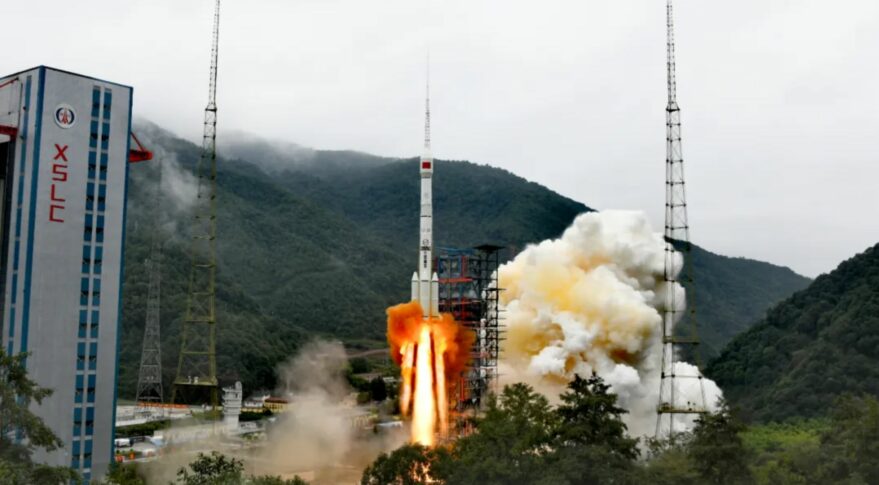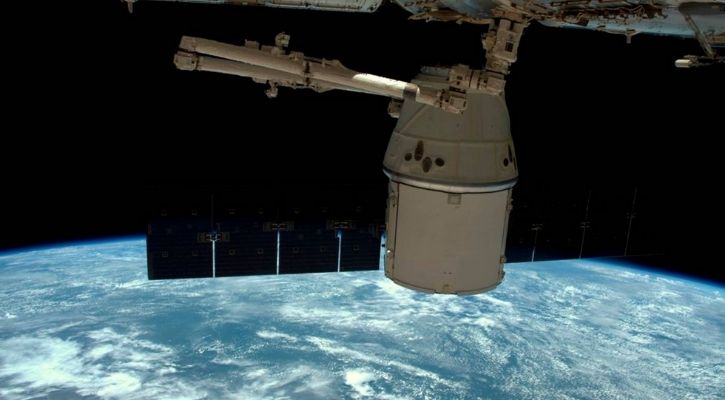An object is now orbiting alongside China’s Shijian-21 debris mitigation satellite

HELSINKI — U.S. space tracking has detected a new object orbiting along with China’s recently launched Shijian-21 space debris mitigation technology satellite.
Shijian-21 was launched into geosynchronous transfer orbit Oct. 23 by a Long March 3B rocket. Chinese state media reported that the satellite would “test and verify space debris mitigation technologies,” but no further details have been revealed.
The Shijian-21 spacecraft was developed by the Shanghai Academy of Spaceflight Technology (SAST). SAST in September unveiled a “supplemental service spacecraft” concept at the Zhuhai Airshow.
On Nov. 3 U.S. Space Force’s 18th Space Control Squadron (SPCS) catalogued a new object alongside Shijian-21 with the international designator 2021-094C. The object is noted as a rocket body and more precisely an apogee kick motor (AKM), used in some launches for a satellite to circularize and lower the inclination of its transfer orbit and enter geostationary orbit.
Apogee kick motors usually perform a final maneuver after satellite separation so as to not pose a threat to active satellites through risk of collision. However both Shijian-21 and the SJ-21 AKM are side by side in geostationary orbit.
It is currently unknown whether the object is an AKM, an object possibly related to space debris mitigation tests, or part of potential counterspace operations tests. The object could be used to test rendezvous and proximity operations, refueling experiments or manipulation using a robotic arm or other means.
Given the lack of transparency the activities of Shijian-21 and its companion are likely to be closely tracked and scrutinized. It also follows complex maneuvers carried out in geostationary orbit by other Chinese test satellites in recent years.
China’s TJS-3 (Tongxin Jishu Shiyan-3) satellite launched in 2018 released a payload of unstated purposes. The pair maneuvered in concert and carried operations including spoofing, which involves coordinated maneuvers at certain times in an attempt to confuse rivals’ space tracking networks.
The activities take place in a context of growing tests of counterspace and clandestine activities in geostationary orbit by China, the U.S. and Russia. An Oct. 28 article published by Breaking Defense highlights some of these activities using videos from commercial space situational awareness company COMSPOC.
These include USA 271, a space surveillance satellite,which approached China’s large Shijian-20 satellite and Russia’s Luch/Olymp approaching to within 1.8 kilometers of a U.S. commercial satellite.
Against this backdrop Lt. Gen. B. Chance Saltzman, U.S. Space Force deputy chief of space operations for operations, cyber and nuclear, suggested Nov. 3 that hotlines could be established with foreign rivals to reduce the risk of an accident or miscalculation triggering conflict, as have been set up previously in other domains and crises.
“I don’t see any reason why a similar approach couldn’t work for the space domain,” Saltzman said.
The nature of the Shijian-21 and the companion “AKM” will likely become more apparent over time, such as if and when the spacecraft maneuver and the nature of any changes of orbits and if these are coordinated. A maneuver by the SJ-21 AKM would indicate an active rather than passive object.
SAST and its parent CASC may also reveal more information if the mission successfully carries out civilian purpose tests such as refueling.
Geostationary satellite servicing is seen as a growing market. Space Logistics, a wholly owned subsidiary of Northrop Grumman, has launched two Mission Extension Vehicles and has released footage of rendezvous with target satellites, while a number of other agencies and companies globally are developing spacecraft and missions.
Strange Object Appears Next To Newly Launched Chinese Satellite In Earth's Orbit
Bharat Sharma
HighlightsThe 'Shijian-21' was launched last month to assess ways in which space debris can be cleaned up in Earth's orbit.Now, a mysterious object has appeared near the recently launched Chinese satellite.
The era of space exploration leaves more room for unanswered questions than it provides answers. Now, a mysterious object has appeared near the recently launched Chinese satellite.
The 'Shijian-21' was launched last month to assess ways in which space debris can be cleaned up in Earth's orbit.
Now, the United States Space Force detected a new object suspected to be a rocket body called an "apogee kick motor" or AKM, designed to pull satellites into a geostationary orbit, according to SpaceNews.
 NASA/Reuters
NASA/ReutersWhat is this strange object?
The object is currently in a geostationary orbit next to Shijian-21. This is odd because AKMs are designed to get out of the way of nearby satellites to avoid a collision.
Owing to this strange behaviour of the suspected AKM, observers are confused. For starters, it could be an entirely unrelated object. The fact that the Chinese government keeps all of its space activities under wraps means we may never find out the true origin and purpose of the object.
While countries claim their new tech is aimed at cleaning space debris, equipping satellites with capabilities to knock down satellites of other countries is a powerful capability, as space becomes the latest place for countries to exercise their power, dubbed as "space wars."
The United States, Russia, and China are at the forefront of this war, as always. Signs of the challenges to come have already become pronounced. For instance, last week Breaking Defense reported that a Chinese satellite was following an American satellite and adjusting its orbit to keep up.

No comments:
Post a Comment